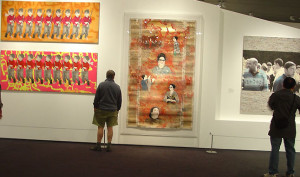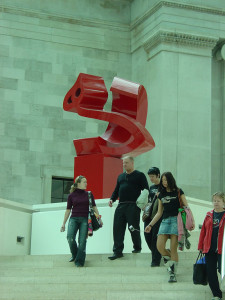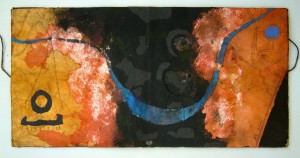Word into Art Artists of the Modern Middle East
I greet you from afar, O greet me back,
O blessed Tigris, river of gardens green.
I greet your banks, seeking to quench my thirst.
Like doves between water and clay aflutter seen.
O blessed Tigris, oft have I have been forced to leave
To drink from springs which didn’t my thirst relieve.
O blessed Tigris, what inflames your heart
Inflames me and what grieves you makes me grieve.
O wanderer, play with a gentle touch
Caress the lute softly and sing again
That you may sooth a volcano seething with rage
And pacify a heart burning with pain.
( translated by Hussein Hadawi).
Entrance to Word into Art, Artists of the Modern Middle East with Iranian artist Parviz Tanavoli Heech in a Cage, 2006, bronze in foreground right
Published online arteeast.org July 2006
WORD INTO ART: ARTISTS OF THE MODERN MIDDLE EAST AT THE BRITISH MUSEUM (MAY 18 – SEPTEMBER 2, 2006) is a major contribution to our perceptions of contemporary art in the Middle East. I attribute its engaging nature to a combination of aesthetic seduction, clear organization, and compelling subject matter. “Word into Art” is based on the premise of the vibrancy of the traditional art of Arabic calligraphy in the context of a sacred script, as well as the transformations of the script by individual artists as they intersect with international contemporary art trends, politics, and their own regional traditions.
Word into Art consists primarily of contemporary works on paper and ceramics, as well as a few paintings, most of it collected by the British Museum since the 1980s. The show attracted a huge grant from Dubai Holding, enabling the museum to have an entire summer of Middle Eastern Programming, as well as an opening symposium that included artists and art historians from Palestine, Iran, Iraq, France, the Netherlands, the United Kingdom and the United States. (1) Because of this funding the museum also commissioned major art works as part of the exhibition, including Blessed Tigris by Iraqi artist Dia al Azzawi, a towering sculpture in the entry of the Great Court of the Museum. The tower is inscribed with a painfully lyrical poem by Iraqi poet and journalist Muhammad Mahdi al Jawahiri who died in 1997. (2)
Although the British Museum has always defined colonialism in art, with its massive collections of sculptures and other art forms removed from countries all over the world, in this case its historical collections provide a deep resonance for the contemporary art works. Venetia Porter, British Museum Curator of Islamic art and the Contemporary Middle East, also demonstrates a deep respect for the Arabic language. She has chosen to include brochures and displays that lay out the Arabic alphabet and some of its different scripts in order to engage the public on more than a superficial level. She also acknowledges the problem of designating the work as “Middle Eastern” (3)
Word into Art reveals an international contemporary culture of which outsiders to Arab culture usually have only the barest glimpse. Reinstallation of Islamic Collections is ongoing at many museums, but pairing historical works with contemporary art is much more productive. It informs us that these countries, of which we hear so much these days in the news, are not simply historic sites or “contemporary war zones full of terrorists” but sites of a sophisticated contemporary culture.
In contrast to the typical Biennial exhibition, which has by now achieved a slick formulaic (one could say colonizing) presentation of aestheticized videos and large scale works with excess uses of materials that say little, this exhibition declares itself to speak, and speak clearly, on many different levels, about contemporary culture. Two of those international Biennial artists appear here, Shirin Neshat and Rachid Koraichi, but now we can understand their perspectives more completely.
The British Museum exhibition is divided into four parts: Sacred Script, Literature and Art, Deconstructing the Word, and Identity, History and Politics. The exhibition opens with a juxtaposition of an elaborate Ottoman Tuğra (official signature) in classical Diwani script and a contemporary emblematic work, by a prominent Iranian sculptor, Parviz Tanavoli. Working in large scale bronze, Tanavoli cast the single Arabic word “heech” written in nasta’liq script and placed it in a cage. The word means “nothing” in Persian. (4) Tanavoli is a central figure in recent Iranian art history, specifically as part of a movement called Saqqakhaneh. (5) The museum commissioned three other “heech” sculptures from Tanavoli in red, yellow, and green, which appear in the Great Hall. Also in this entry gallery are photographs of all of the artists in the exhibition, thus underscoring that they are contemporary men and women. The first room prepares us for an exhibition that honors tradition, transformation of tradition, and the contemporary world.
“Sacred Script” focuses on the fact that Arabic script originated in the writing of the Qur’an, the word of God to Mohammed, in the 7th century. Consequently, it has always had a sacred aspect that sets it apart. In the first gallery, the artists are from Iraq, Iran, Syria, Japan, China and Turkey. One theme, the curator explained, was to demonstrate that Arabic calligraphy linked with the spread of Islam exists all over the world. (6)
The most visible calligrapher was Hassan Masoudy, an Iraqi living in France, who created the main insignia of the exhibition. The posters feature the phrase from an early Sufi master “I follow the religion of Love, whatever way Love’s camels take, that is my religion and my faith,” in red Kufic script, then the creatively enlarged word “love” in a sweeping gestural movement. (7) Thus in the first section of the exhibition, we are already aware that Arabic has sacred roots and functions—that it is a living, international art expression, and that it is constantly being transformed by contemporary artists, as well as practiced in many different styles of script that cross geographical and historical boundaries.
In other words, the monolithic Arab and monolithic Islam, as promoted by politicians and the Western media, metamorphoses into a subtle, spiritual, worldwide, changing contemporary culture before we leave the first gallery.
While all of the works in the first section are designated as sacred because they directly quote the Qur’an, the second section of the exhibition “Literature and Art” emphasizes another dimension of Arabic, its powerful, long lasting poetic and literary traditions (its endurance partly based on oral recitation and memorization in school). The references include pre Islamic poets, mystics, Sufi masters, and recent poets from countries who use Arabic or Persian, including the famous Palestinian poet Mahmoud Darwish. His beautiful “Birds Die in Galilee” is the poem in a book of monoprints by Algerian artist Abdullah Benanteur: “Flocks of birds fell like paper/into the wells/and when I lifted the blue wings/ I saw a growing grave/ I am the man on whose skin/chains have carved a country.” (8)
The artists work with literary traditions in varied ways, ranging from illustrations of specific texts to abstract references, in styles with meticulous detail or free form expressionism. Sometimes, two artists refer to the same poet such as Adonis, the well known Syrian poet and literary critic who now works in Beirut. Adonis’ poem “Beginnings of Words” is presented in a book by the Palestinian artist Kamal Boullata with text framed in geometric shapes, while Iraqi artist Dia al- Azzawi gives us an expressionist figurative rendering of “Harlem,” an excerpt from Adonis long narrative poem A tomb for New York from 1971. What is obvious from these two examples, and indeed every work in this section is that the cultured artists, poets, and intellectuals of the Arab and Persian world revere one another, and form a culture that crosses national boundaries continuously, both in their work and in their own physical positions within that world. Shirin Neshat, inscribing the poetry of Iranian Farough Farokzad on her photographs, and Rachid Koraichi collaborating with Algerian novelist, Mohammed Dib, are part of a tradition of homage.
Koraichi is also included in the next section of the show “Deconstructing the Word”. His usual position within international Biennials, as a token Middle Eastern artist using Arabic writing, is here embedded in a context that reveals what his work is really about. Deconstructing the Word refers to the resonance of the Arabic letter forms in themselves, as aesthetic objects, nationalist signifiers (for the modern abstract artists of the mid century in Iraq for example (9)), magical incantations and protections, and talismans as sources of healing. Many of these qualities are aspects of Koraichi’s use of Arabic. He is a smuggler bringing these powerful references to European public art. (10)
Another familiar name that makes a surprise appearance in this section is Siah Armajani. His early work Letter, 1960, is based on his love of Persian poetry and calligraphy. That rich connection has metamorphosed in his American public art into texts in English (such as quotes from Moby Dick in a Seattle public art work). Ceramic art by Tunisian artist Ben Slimane, includes repeated letters that are sometimes legible, sometimes not, invoking a tradition of religious incantation. Another stunning ceramic piece by Saudi artist Faisal Samra is shaped like a peaked hat densely inscribed with Arabic letters separately written in the style of amulets meant to ward off evil.
The final section of the exhibition, “Identity, History and Politics,” includes artists who foreground political subjects, even as they continue in the tradition of framing image and words, poetry and writing, as a single entity. In a work where we might ignore the Arabic writing in the background, it is now clear that the word and image are inseparable. For example, Khosrow Hassanzadeh is an Iranian artist who makes large paintings that invoke Persian miniatures in their style. A figure (a self portrait of the artist) kneels against an ornamental background, but texts on his chest and across his head refer to his disillusionment with life. As a child he was forced to fight in the Iran/Iraq war, an eight year war encouraged by the United States (who armed Saddam Hussein), in order to destabilize the region. The poem as translated in the exhibition reads in part “And the act of demolishing becomes a basis for another destruction and each destruction follows a demolition after a construction. And when everything is destroyed, it is only the legend that seems real.” (11)

Artists left to right Laila Shawa Children of war, children of peace, 1995 silkscreen on canvas; Chant Avedissian Umm Kulthum’s greatest hits, 1990s, pigment on recycled board, Sabah Naim Cairo Faces, 2005, painted photograph on canvas and newspaper
An example of Palestinian Laila Shawa’s long term photographic project Walls of Gaza dominates the last room. Two large scale paintings repeat a silk-screened photograph of a little boy who appears to hold a stick that can be a play gun or a play hobby horse. Behind him is bright orange, yellow and pink graffiti that the artist has photographed. The text is illegible, the graffiti in Gaza is routinely spray painted over by Israeli occupiers.
The most searing images of the entire exhibition for me, though, were two small scaled works by Iraqi artist. Kareem Risan. In the first untitled work, he created a thirty page book in mixed media which has the appearance of a burnt, destroyed book, with orange, black colors, and a hollow center. It has no text. The artist refers here to the burning of the Baghdad library shortly after the United States’ invasion of Iraq. It has horrifying significance because of the deep connection and central position of words, poetry and books in Arab and Persian culture. Risan’s second small book called Uranium Civilization uses dark blood reds and blacks combined with spirals and pyramids to refer to the use of depleted uranium as a cause of illness and death following the first Gulf War.
A book by Maysaloun Faraj, History in Ruins, is made out of ceramic with the two sides tied together with straw. The text is an invocation of God and the question “why.” The surface appears burnt. The work makes reference to the destruction of not only the library, but also thousands of cuneiform tablets that were stolen at the beginning of the occupation. (12)
The exhibition as well as the book that accompanies it, which includes detailed explanations of each work, and a helpful introduction by Venetia Porter, is an invaluable intervention in the usual clichés and stereotypes that dominate Western understanding of the Arab and Persian world. The overall message is straightforward: a belief in poetry, humanity, and reverence as an alternative to materialism, capitalism, and power struggles. The international artists presented here are part of a powerful oppositional force that offers an alternative world view to our cliché media messages.
NOTES:
1. For the complete program visit www.thebritishmuseum.ac.uk
2. “I greet you from afar, O greet me back/ O blessed Tigris, river of gardens green/I greet your banks, seeking to quench my thirst. /Like doves between water and clay aflutter seen. /O blessed Tigris, oft have I been forced to leave/to drink from springs which didn’t my thirst relieve./O blessed Tigris, what inflames your heart/inflames me and what grieves you makes me grieve./ O wanderer, play with a gentle touch;/Caress the lute softly and sing again. That you may soothe a volcano seething in rage/And pacify a heart burning with pain” transl by Hussein Hadawi.
3. She commented in a public gallery talk that the definition of “Middle East” was loosely expanded to include artists from countries in North Africa and, at the symposium, stated that the artists preferred national identities, in spite of all the obvious political problems associated with that. Another perspective offered to me by Shiela Blair, author of Islamic Calligraphy, Edinburgh University Press, 2006) was that “Western Asia” would be more accurate.
4. Nasta’liq means “hanging script” based on a dream about flying geese according to legend, popular in India and Iran from the fifteenth century.
5. Rose Issa, Ruyin Pakbaz and Daryusy Shayegan, Iranian Contemporary Art, ( Barbican, 2001) on the Saqqakhaneh school and its use of the reference to the martyrdom of the Prophets grandsons denied water at Karbala in the 7th century, 18,19. The cage may reference a grill to which religious talismans are attached at votive fountains. When pressed for what the work means, the artist declared it meant “nothing”, but in his repetition “nothing” became a philosophical statement.
6. In order to underscore the idea that calligraphy is a living changing tradition, the Museum brought in five artists for a Sunday afternoon program. Professor Fou’ad Kouichi Honda, came all the way from Japan, to demonstrate refined Ottoman based calligraphy which he studied for ten years in Istanbul. Behnam Keryo, an Iraqi living in France, wrote in traditional cuneiform on clay tablets . Mouneer al Shaarani from Syria wrote in traditional North African script, Lassad Metoui Tunisian (living in France) created a large scale work as a contemporary performance.
7. The poem is taken from Muhyi al Din Abu Bakr ibn Muhammad ibn al-‘Arabi
( 1165 – 1240), an influential Sufi master. These words come from a collection of 61 mystical odes. Venetia Porter with contributions by Isabelle Caussé, Word into Art, Artists of the Modern Middle East, British Museum 2006. Venetia Porter, Word into Art, p. 61.
8. Word into Art, 52. Translated by Kabbani 1986.
9. Nada Shabout, “Modern Arab Art and the metamorphosis of the Arabic letter, Ph.D. dissertation, University of Texas at Arlington, 1999.
10. This term is used by Simon Harvey “Smuggling Practices into the Image of Beirut,” Out of Beirut, Oxford Modern Art, Oxford, exh cat, 2006. This exhibition is on until July 16.
11. Venetia Porter, et. al, Word into Art, p. 103 for the entire poem.
12. Maysaloun Faraj, also owns the Aya Gallery in London and organizes exhibitions. Maysaloun Faraj, ed. Strokes of Genius, Contemporary Iraqi Art, 2001 is an invaluable reference on contemporary Iraqi art.
This entry was posted on June 14, 2007 and is filed under Art and Politics Now, art criticism, Iraqi Art, Iraqi contemporary art, Uncategorized.












